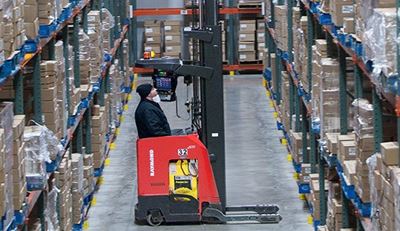3 Steps for Preparing Your Warehouse for an Economic Cooldown

Even during busy times, warehouse managers should consider ways to optimize their operations for leaner periods, such as when an economic contraction or recession occurs.
By investing in the right tools, analyzing relevant data and identifying potential problem areas, warehouses can better prepare for an inevitable economic cooldown.
The thought of an economic slowdown may make managers nervous, but investing wisely now in tools that can help overall productivity will protect warehouses from potential losses later. Managers should consider the following steps now to prepare their warehouses for an economic contraction.
Step 1: Invest in telematics
Investing in telematics can save warehouses from potential losses in productivity and damage. The data these systems gather set a baseline to aid in identifying issues that are affecting a warehouse’s bottom line. However, before fully investing in telematics, managers should determine related expenses to ensure that these costs can be offset and align with long-term financial goals.
Managers may be hesitant to invest in telematics when a slowdown in business is coming, but this move is a wise investment. If things like fleet utilization, operator performance and scheduled maintenance have not been consistently tracked, then it is more difficult to identify areas of loss and inefficiency. Additionally, many vendors offer leasing or subscription options so that telematics can be considered an operating expense rather than a strict capital expense. When warehouse managers invest in telematics, they can get new insights as to where they can improve operations — ultimately, saving time and money.
Step 2: Analyze data
After investing in telematics, managers can establish a baseline value of different operating metrics. This allows managers to pinpoint facility and operating inefficiencies and determine opportunities for labor and fleet optimization. By analyzing the available telematics data and optimizing the warehouse, managers can make informed decisions about where improvements are needed in preparation for an economic cooldown.
Managers should regularly analyze the data and adjust warehouse operations accordingly. For example, looking at the least productive parts of a warehouse, potentially hazardous areas, and how often forklifts are in use can help optimize operations. Vendors offer professional services to assist warehouse managers in analyzing data. If there is an area of the warehouse that isn’t as effective as the others, looking at the data and seeing what can be improved — or even eliminated — can save the warehouse from losses. Warehouses should be as optimized as possible so they aren’t affected significantly by a cooldown.
Step 3: Improve inefficiency patterns
Telematics data can be used to expose inefficient patterns and areas of opportunity. For example, telematics data can be used to assess whether a warehouse should buy or rent its warehouse fleet, automate a facility or address other labor concerns.
Before making any major decisions pertaining to the whole facility, managers should first consult the data. That information can help them determine if their current fleet and labor force is meeting their needs. Are there new attachments or features needed for peak performance? Is leasing or renting lift trucks the right fit for the warehouse? Data can help warehouse managers prepare and answer these questions.
In the end, preparing for an economic cooldown doesn’t need to be as nerve-wracking as it might initially seem. By investing in telematics data tools, analyzing available data and improving potential problem areas, warehouses can be ready when a lean period hits.
Submitted by John Rosenberger, director of iWAREHOUSE Gateway and Global Telematics, The Raymond Corporation
Plant Services, Today's Optimized Facility
Read the original post: https://www.plantservices.com/blogs/todays-optimized-facility/3-steps-for-preparing-your-warehouse-for-an-economic-cooldown/

